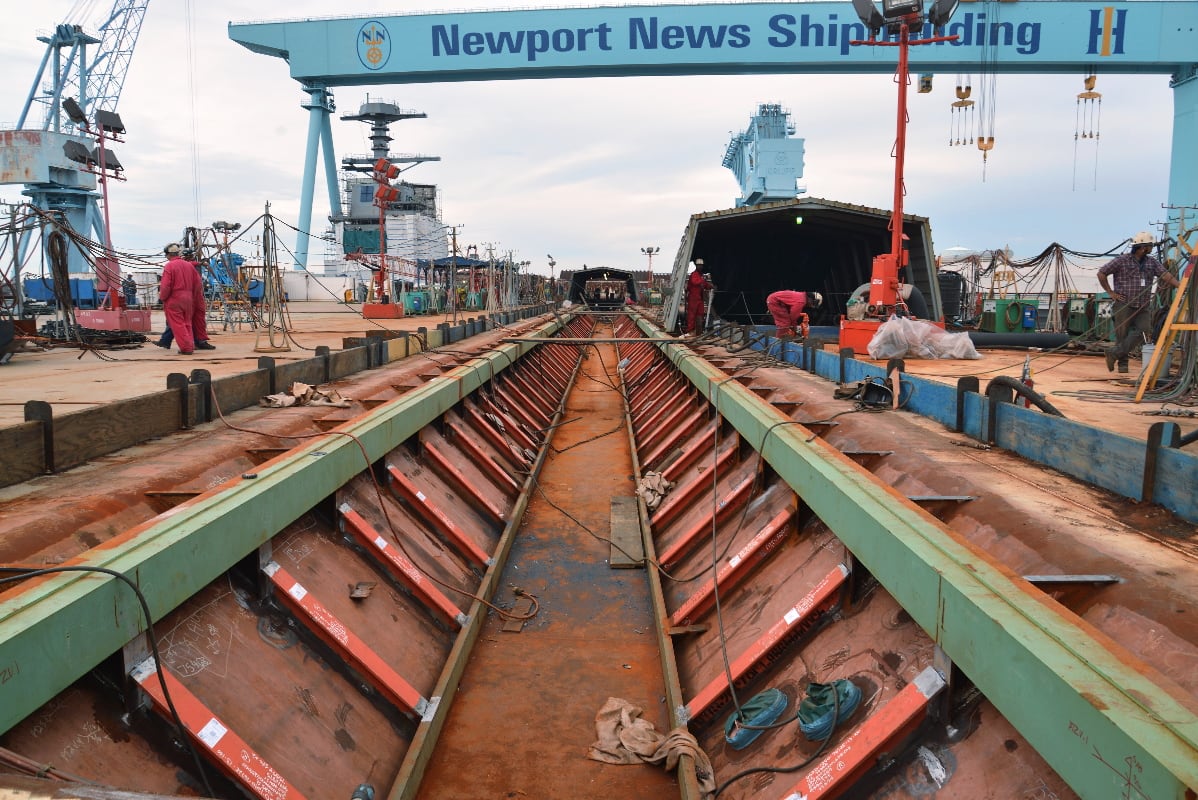NEWPORT NEWS, Va.— The failure of what was to be the first public shot of the electromagnetic aircraft launch system aboard the carrier Gerald R. Ford did little to help the embattled catapult's reputation.These two grafsThe electromagnetic aircraft launch system successfully launched weighted sleds off carrier Gerald R. Ford's bow, but after a public misstep that this milestone did little to help the embattled catapult's reputation.
What was to be EMALS' first public shot proved to be a failedure to launch.
Officials on the morning of June 16 placed a weighted sled at the end of Catapult 1. After a successful dry run, the Navy crew set up for one more test. The catapult officer gave the command, the shooter pressed the launch button inside the cab, and … nothing.
The exact problem was not immediately clear. Matt Mulherin, president of Newport News Shipbuilding, said some of the circuitry was showing faults. The carrier's skipper categorized it as a "communication-type issue of components talking together."
though oOfficials were quick to label the miscue a "minor setback" and express confidence that EMALS will be operational as scheduled.
On Tuesday morning, officials on the morning of June 16 placed a weighted sled at the end of Gerald R. Ford's Catapult 1. After a successful dry run, the Navy crew set up for one more test. The catapult officer gave the command, the shooter pressed the launch button inside the cab and … nothing.
The exact problem was not immediately clear. Matt Mulherin, president of Newport News Shipbuilding, said some of the circuitry was showing faults. The carrier's skipper categorized it as a "communication-type issue of components talking together."
"We would have liked to have seen this shoot today," Capt. John Meier, Ford's commanding officer, said. "I'm certainly not disappointed in where we are in the test program. … I think that what we have today is a minor setback to the test program. We will get back on track [and] our team knows that. As a matter of fact, you don't see them around right now because they are getting after it."
After media left, officials reported the system was fixed and successfully launched two dead loads around 1 p.m. The first weighed 15,000 pounds and traveled at 140 knots. The second dead load weighed 8,000 pounds and traveled at 180 knots. Meier's goal was to fix any issues that had occurred in recent testing by later in the afternoon. Another 20 testing days with weighted sleds remain aboard Ford. The planned operational launch of aircraft is set for 2017.
This grafOfficials said shipbuilders and the crew previously launched 14 sleds of varying weights and speeds from Catapult 2. The first two were on June 5, then one on June 10, and another on June 12. Shipbuilders and the crew have launched 15 sleds of varying weights and speeds from Catapult 2 in three days. Similar issues were seen amid those successful launches, Meier said.
"As you go through the testing program, it is not uncommon to have hiccups, if you will, or minor discrepancies," he said. "We have seen nothing that I would consider a major test interruption whatsoever."

The electromagnetic aircraft launch system aboard the carrier Gerald R. Ford failed to work during its first public test. Officials called it a minor setback. Here, the trough holding the carrier's No. 3 catapult is seen shortly before the flattop's christening in October 2013.
Photo Credit: Christopher P. Cavas/Staff
The team netted 10 consecutive shots once the issues on Cat 2 were corrected.This grafThe issues on Cat 2 were corrected on June 15 and the team netted 10 consecutive shots.
"This is why you run a test program. You find the faults, you fix them," Mulherin said. "Some of this is new hardware that wasn't fully tested at the site in Lakehurst [in New Jersey]. At the end of the day we will deliver a product that is fully spec compliant, that meets all the captain's demands and that is reliable.
"But today isn't going to be the day that we can demonstrate that."
The EMALS catapult replaced the steam-powered catapult system, and has had its share of problems. By the time aircraft compatibility tests ended in April 2014, and more than 3,000 dead-load launches were added to the mix, EMALS had a reliability rate of 240 launches without a failure. That was far short of the 1,250 launches the system should have been hitting at that point.
EMALS is expected to reduce stress on aircraft during takeoff, thus expanding their service lives. It is designed to increase the sortie generation rate by as much as 25 percent and can launch a wider variety of weights in varying wind conditions. This includes lightweight, unmanned aerial vehicles that cannot be launched with a steam catapult.





